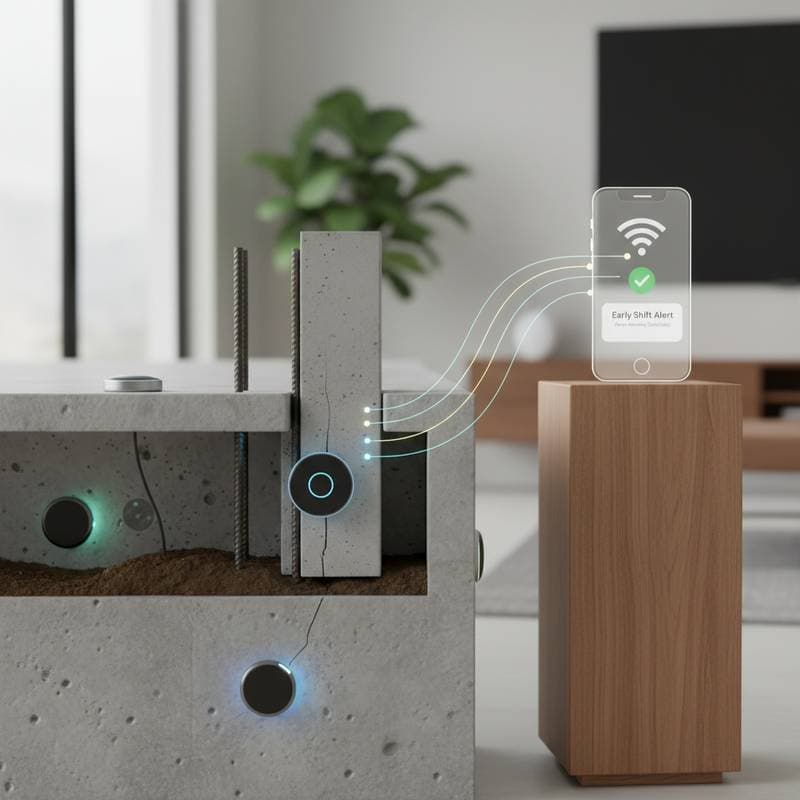Understanding Early Detection of Foundation Settling with Smart Sensors
Foundation settling occurs gradually, frequently without noticeable signs until cracks develop or doors fail to align properly. Smart sensors provide homeowners with an effective method to identify minor shifts before they escalate into major structural problems. These devices monitor movement, vibrations, and moisture surrounding the foundation, transmitting alerts as soon as irregularities arise.
Functions of Smart Foundation Sensors
Smart foundation sensors observe the movement and positioning of a home's base structure. They incorporate accelerometers, tilt meters, and moisture probes to capture variations in alignment and soil conditions. Information transmits to a mobile application or central monitoring unit, allowing users to review patterns and obtain timely notifications. The primary objective remains the identification of settling issues before impacts extend to walls, floors, or plumbing systems.
Advantages and Disadvantages
Advantages
- Identification of settling or movement prior to observable damage
- Reduction in repair expenses through early intervention
- Ongoing surveillance without the need for physical examinations
- Historical data that assists engineers in determining root causes
- Integration with additional smart home technologies for notifications and analytics
Disadvantages
- Dependence on reliable internet connectivity and power supply
- Initial expenses for equipment and ongoing subscriptions
- Potential for erroneous notifications in areas with elevated vibrations
- Necessity for precise calibration of sensors
- Diminished effectiveness if soil displacement has progressed significantly
Cost Considerations
The pricing of smart foundation sensors depends on the model and the scale of the system.
- Individual sensor units: Range from 80 to 150 dollars per device
- Entry-level kits for smaller residences: Approximately 400 to 800 dollars
- Comprehensive professional monitoring setups: Between 1,500 and 3,000 dollars, including installation
Costs increase with features such as additional moisture detectors, extended wireless coverage, or advanced application-based data recording. Monthly subscription fees for cloud storage or alert services typically range from 5 to 25 dollars. Professional evaluations may prove essential for analyzing movement data or confirming underlying issues.
Durability and Upkeep
Sensors generally endure for 5 to 10 years, influenced by battery performance and environmental exposure. Examine batteries annually and remove accumulated dust or debris from the sensor enclosures. Replace deteriorated seals on units positioned outside. Conduct monthly reviews of data to identify atypical patterns. Recalibrate or substitute sensors that exhibit consistent deviations or connectivity failures.
Key Specifications for Purchase Evaluation
- Precision levels: Select units with at least ±0.1 degree accuracy for tilt measurements and ±0.1 millimeter for displacement detection
- Wireless coverage: Ensure the range extends to the router or hub, even through basement barriers
- Resistance to moisture: Opt for waterproof or sealed designs suitable for humid environments
- Power options: Choose between battery-operated or low-voltage wired models based on placement
- Application integration: Verify compatibility with existing home automation platforms
Preparation Steps
Examine the foundation for suitable access points prior to setup. Sensors require firm attachment to concrete or structural elements, avoiding unstable soil. Steer clear of placements near sump pumps or heavy machinery, as vibrations can interfere with readings. Address any existing drainage concerns beforehand, since pooled water may skew moisture readings.
Installation Process
- Identify optimal positions for sensors at foundation corners, load-bearing walls, and basement slabs.
- Prepare surfaces by cleaning them and affixing sensors using epoxy adhesive or anchor screws.
- Link sensors to the home Wi-Fi network or central hub, then verify signal quality.
- Calibrate each sensor on a flat surface prior to permanent installation.
- Configure the application interface and establish thresholds for movement or moisture alerts.
- Document initial readings after a one-week stabilization period.
Basic tools such as a drill, spirit level, and smartphone suffice for the process. Most homeowners complete the installation within a few hours.
System Types and Features
Options include wired, wireless, or hybrid configurations.
- Wired systems offer consistent data transmission but demand electrical wiring and cable routing
- Wireless sensors facilitate straightforward retrofitting, particularly in rental properties
- Hybrid systems merge both approaches, ideal for expansive homes
Certain models incorporate humidity and temperature sensors to observe freeze-thaw effects or internal climate influences.
Self-Installation Versus Professional Assistance
Straightforward systems lend themselves to self-installation for those comfortable with leveling tools and application guidance. Engage professionals in these scenarios:
- Existing indications of cracks or floor unevenness
- Intent to synchronize data with broader building management systems
- Complex foundation designs, including pier-and-beam or post-tensioned constructions
- Requirement for certified calibration to uphold warranties or insurance coverage
A structural engineer can analyze sensor outputs and suggest reinforcements if displacement persists.
Troubleshooting Common Issues
- Erroneous notifications: Inspect for insecure fastenings or interference from heating, ventilation, and air conditioning equipment
- Connectivity interruptions: Install signal boosters or relocate the central hub
- Moisture penetration: Seal access routes and substitute damaged connections
- Inaccurate readings: Perform recalibration using a verified stable benchmark
The majority of problems stem from inadequate installation or neglected maintenance, rather than inherent sensor flaws.
Considerations for Regional Climates
In areas with cold weather, freeze-thaw cycles exert pressure on soil and foundations. Select sensors designed for subzero conditions and position them within the structure when feasible. For coastal or high-humidity regions, prioritize corrosion-resistant models equipped with moisture detection to identify rising groundwater.
Non-Digital Monitoring Alternatives
For those hesitant about technological solutions, traditional crack gauges or basic tilt indicators offer affordable oversight. These methods necessitate periodic visual inspections but effectively indicate ongoing activity.
Maximizing Sensor Performance
Establish a reliable baseline by recording data during periods of foundation stability and typical soil moisture. Respond to notifications without delay rather than disabling them. Pair sensor insights with yearly assessments of drainage and site grading. While sensors cannot halt settling, they afford the opportunity to address concerns before repair costs escalate.
